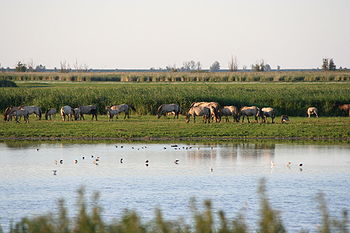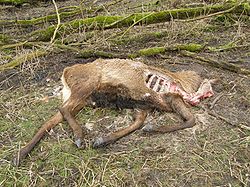- Oostvaardersplassen
-
The Oostvaardersplassen (Dutch pronunciation: [oːstˈvaːrdərsplɑˌsəⁿ]) is a nature reserve in the Netherlands, covering about 56 square kilometres (22 sq mi). Despite having developed recently (it is in a polder which was only created in 1968) it already has international importance as a European wetland.[citation needed]
The Oostvaardersplassen can be divided into two areas: wet and dry. In the wet area along the Markermeer, there are large reedbeds on clay, where moulting geese often feed. This area is also home to Great Cormorant, Common Spoonbill, Great Egret, White-tailed Eagle and Eurasian Bittern, among many other animals.
Contents
History
Before the establishment of the reserve, the dry area was a nursery for willow trees, and in the first year hundreds of seedlings could be found on each square metre. This led to concern that a dense woodland would develop, significantly reducing the value of the habitat for water birds. To avoid this, the park's managers brought in a number of large herbivores to keep the area more open, including Konik ponies, red deer and Heck cattle. These large grazing animals are kept out in the open all year round without supplemental feeding, and are allowed to behave as wild animals (without, for example, castrating males). The ecosystem developing under their influence is thought to resemble those that would have existed on European river banks and deltas before human disturbance.
Large herbivores
Before they were driven to extinction, large herbivores in this part of Europe included the tarpan (wild horse), wisent (European bison), red deer, elk (known as moose in North America) and aurochs (wild cattle). The tarpan and aurochs are extinct, but Konik ponies and Heck cattle are able to act as functional equivalents, occupying a similar ecological niche. The only native large herbivores now missing from Oostvaardersplassen are the elk, the wild boar and the wisent. It is unlikely that elk will be introduced due to its similar ecological niche to the three established grazing herds, putting too much pressure on plant growth; but there is hope for wisent as it fills a different niche from cattle. There is a chance that the wild boar will find its way naturally from the Veluwe.
Natural processes
Given that the Oostvaardersplassen is below sea level, many of its primary processes have been regulated. As the wetlands have been so spectacular, a dyke was made around it to prevent the process of groundwater-related subsidence. While this had temporary advantages, it created a water body with no open connections to the rest of the polder and the negative effects are only now being understood.[further explanation needed]
The cattle, deer and horses have multiplied in the Oostvaardersplassen. However there is a limit to the number of animals the area can sustain. In the absence of natural predators the rangers shoot animals that are unlikely to survive. It is quite natural for 30% to 60% of the population to die in this way. After a die off, the vegetation has a chance to recover and this will get the first natural afforestation of the area under way.
Future development
In many ways the Oostvaardersplassen is an isolated area; it is in a polder and there are currently no corridors connecting it to other nature reserves. The "Ecological Main Structure" (a proposed connection of nature reserves in the Netherlands) calls for a corridor to be created to the nearby Horsterwold. The resulting network, called Oostvaardersland, would be part of Natura 2000, the European-wide network of habitats to which Oostvaardersplassen belongs.[1] Oostvaardersland is expected to be finished by 2015 and will comprise a total area of 150 square kilometres (58 sq mi). Furthermore, there is an option for a connection to the Veluwe forest. Eventually this could allow wild animals to move to and from Germany and France.
The advocates of natural processes are also planning for the wet part of the Oostvaardersplassen to be drained.[clarification needed] It is expected that the natural subsidence will lower the ground level and that this will result in a more natural and dynamic system.
References
External links
- Oostvaardersplassen animal photos & much more details
- Oostvaardersplassen fauna photos
- Birds Calendar Oostvaardersplassen
- Animals and plants found in the Oostvaardersplassen
- largeherbivore.org/oostvaardersland-oostvaardersplassen-oostvaarderswold-horsterwold
- Oostvaarderswold ecological corridor (nl)
Categories:- Visitor attractions in Flevoland
- National parks of the Netherlands
Wikimedia Foundation. 2010.






